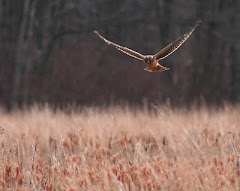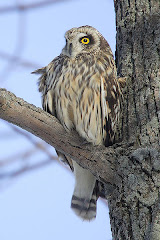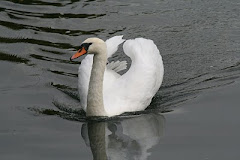.jpg)
‘Curtain twitching’ takes on a whole new
meaning when you live in a house in the country with no neighbours within half
a mile. It’s the early morning peep through the curtains before opening them
fully, just in case there is some interesting wildlife scene unfolding outside
the window. Disappointment usually follows, but as the house overlooks a river,
or ‘drain’ as the Environment Agency rather unromantically calls it, I always
lived in hope of seeing one of my favourite birds.
I knew there were kingfishers on this
stretch of the river, and one of the first things I did after moving into the
house was to provide a wooden post at the edge of the water from which they
could fish. Not once in two years had this facility been used, although on one
memorable occasion, as I peered through partly opened curtains, I was able to
watch a kingfisher, not fishing, but bathing and preening on a paving stone
alongside the perch. For several heart-stopping minutes, it repeatedly dropped
into the water and returned to its position to groom its spectacular feathers.
Occasionally, a moment of quiet
contemplation at the window has been rewarded with a fleeting glimpse of what
looked like a turquoise Exocet missile, streaking along the river just a few
inches above the water. How true that some of the best sights occur when you
are not looking for them! Similarly, looking for a particular creature will often
lead to something totally unexpected.
My first thought on this particular
morning, as I peered through a gap in the curtains, was that someone had lost
their ferret. I had seen ferrets before, and know they come in a huge variety
of colours, but I had never seen one this colour before. How it took me so long
to correctly identify it remains a mystery, and it was only when I was
describing it to a work colleague that the penny finally dropped. ‘Dark brown,
almost black, beautiful glossy fur’ - of course it wasn’t a ferret, it was a
mink!
The American mink was first brought to
Europe in the late 1920s, and they were bred for their coats in commercial mink
farms all over Britain. Escapees, and possibly individuals released by animal
rights activists, quickly established a wild breeding population, first
reported in 1956, and they are now a well-established feature of Britain’s
waterways.
I recall a family day out, at some time in
the mid-1980s, walking part of the ‘Viking Way’ by the River Bain. We spotted a
group of hunters in green jackets and long boots, with hounds of some sort, and
we were curious to find out the nature of their quarry. My teenage niece, far
more out-going than anyone else in our family, approached the group of hunters
and asked them what they were hunting. “Mink and coypu” they replied. Both are
invasive species from the Americas with similar histories, although the latter
were finally eradicated in 1989.
Thrilling as it is to see wild animals in their natural environment, I admit to having mixed feelings about seeing a mink. They are fearsome hunters, with no natural predators, and are responsible for eating huge numbers of water vole and riverside birds. I am sure it is no coincidence that it was another anxious six months before I caught a glimpse of a water vole, one of our most treasured neighbours, swimming purposefully across the drain outside our house.

















.jpg)
























No comments:
Post a Comment